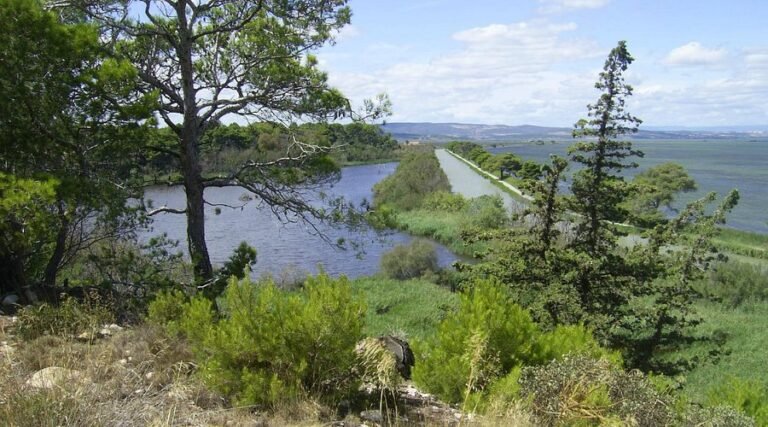Complete Guide to the Lle-Lucie NatureReserve: a preserved jewel at the gates of Narbonne
The Narbonne region, in Aude, is full of exceptional naturesites, and the Lle-Lucie Naturereserve is certainly part of it. Located just a few kilometers from the city, this reserve is a real paradise for naturelovers, hikers, photographers and all those who seek to immerse themselves in a preserved environment, between lagoons, piners, old salins and wild beaches. In this detailed guide, you will discover everything you need to better prepare your visit: site history, LS naturebackground, remarkable fauna and flora, discovery routes, practical information, eco-responsibility advice and much more.
Whether you are simply curious or passionate about natureL, the Lle-Lucie NatureReserve promises you a day or a memorable stay in the immediate vicinity of Narbonne. Happy reading and good exploration!
Summary

General presentation of the Lle-Lucia NatureReserve
Geographical situation and protection status
Lle-Lucie Nature Reserve Nature of Sainte-Lucie", is located in the town of Port-la-Nouvelle, about 20 kilometers south of Narbonne. It covers more than 800 hectares and is an integral part of the Narbonnaise Regional Park in Nature Mediterranean . Its positioning, between ponds, lagoons and Mediterranean coast, gives the site a great richness of ecosystems.
Administered by the Littoral Conservatory , the reserve's mission is to protect and enhance rare environments, while allowing the public to take advantage of the nature . This protection status requires strict rules concerning access, fauna, flora and layout of trails. This guarantees the sustainability of this jewel of biodiversity, which almost disappeared due to various human pressures (salinization, agricultural exploitation, urbanization, etc.).
A biodiversity setting close to Narbonne
The geographic proximity to Narbonne makes Saint Lucia an ideal destination for tourists who wish to escape in the heart of nature without browsing long distances. You can make sure of a cultural morning in the historic center of Narbonne, then spend the afternoon in total immersion in a wild environment, far from urban agitation.
This duality (city of art and history on the one hand, vast natureterritory L on the other) seduces a varied audience: lovers of old stones, families in search of easy walks, groups of ornithologists, amateur photographers ... The Lle-Lucie Naturereserve is a major tourist asset for the region, while playing an essential role in the preservation of more and more rare ecosystems.
Varied landscapes: when the Mediterranean coast meets the lagoons
Mosaic of LS natureenvironments
One of the great advantages of the reserve is the LS nature environments it contains. In the space of a few kilometers, the visitor crosses several contrasting environments:
The ancient salines : witnesses of an era when the extraction of salt was a major activity in the region, these basins draw large flat surfaces, punctuated by dikes and canals. When summer arrives, delicate pink or mauve shades (notably thanks to the silts and statices in bloom) cover certain areas, offering photographers superb shooting opportunities.
Wetlands and marshes : around salt and lagoons, we find wetlands essential for the nesting and wintering of many species of birds. These spaces are characterized by halophilic vegetation (suitable for salt), such as salicorn and sea soda.
Sansouïres : also called "salty steppes", they are formed in areas periodically flooded by salt water, where only very resistant plants can survive. The landscapes of Sansouïres are typical of the Mediterranean coast still preserved.
Pine -sodes and moors : while moving away from the lagoons somewhat, the terrain rises. Large spaces of garrigue and pine forest cover the island Sainte-Lucie, offering shadow and freshness in the heart of summer. Aleppo pine is the dominant essence, associated with other Mediterranean species such as Kermès oak or juniper.
The beaches and wild dunes : at the eastern end of the reserve, the Mediterranean coast forms long sandy beaches. The most famous is the beach of the old news, which has remained in nature nature . The dunes in the background, unstable and swept by the wind, house a rare and fragile flora.
This alternation of various environments is reflected in remarkable biodiversity , both in the flora and fauna, in particular avifauna.
Sainte-Lucie island: a singular space
At the heart of the reserve, the island Sainte-Lucie, separated from the continent by the Canal de la Robine, is a major pole of the naturalist discovery. Visitors have accessed on foot or by bicycle from the Port-la-Nouvelle lock. On this island, the contrast is striking: we pass in a few minutes of trails shaded by pines at impregnable views of lagoons or the sea. The vestiges of the old agricultural, viticultural and salt activity are harmoniously mixed with LS naturehabitats, recalling the historical role of man in the development of this territory.
Wildlife and flora: the richness of an ecological hotspot
A Mediterranean flora adapted to salinity
The vegetation of Sainte-Lucie is characterized by an extreme adaptation to difficult conditions: salty soils, summer drought, sa sea and sometimes violent winds. Among the emblematic species, we find:
Statices and silts : recognizable by their small purple flowers, appreciated by photographers for the touch of color that they bring to the heart of summer.
Salicorns : These succulent plants form green or red carpets depending on the season, often in the most salty areas.
Maritime soda (Suaeda Vera) : Small halophile shrub, sometimes confused with the Salicorn, which forms dense bushes on savory soils.
The maritime panicaut (Eryngium maritimum) : spine and bluish, rare and protected plant, which is observed on the dunes.
The pines of Aleppo and the garrigue **: Out of wetlands, the pine forest is, punctuated by Kermès oaks, rosemary, thyme and juniper.
In addition to these highly typed species "Mediterranean coast", there is also a more common flora, especially on the darker and rocky parts of the island. This vegetable mosaic is a refuge for many species of insects and birds.
Avifauna: a paradise for ornithologists
The ornithological wealth of the reserve is indisputable. Sainte-Lucie constitutes a site of choice for nesting, wintering and migration of multiple species. Among the most notable:
Flemish pink : often observable in the ancient salins or the surrounding ponds, they add an exotic note to these landscapes.
Elegant avocet, white stilts and beefers : lovers of shallow wetlands, they find in the marshes a conducive place to feed and reproduce.
Dwarf sternes, Pierregarins, Goélands sternes : particularly active on dikes or beaches, especially during the breeding period in the spring.
Ducks and limits : in winter, many species come to winter in the reserve (winter sarcelle, duck duck, etc.).
Passerages : the Rousseline Pipit, the calendelle lark and many other nesting species appreciate the garrigue, the pine forest or the fringes of wetlands.
For lovers of ornithology, it is advisable to come equipped with binoculars or a long-shot. Guided tours or the “Birdwatching” mobile application of the Narbbonnaise Regional Park Nature Narbonnaise is of great help to identify the species.
Other animal species
Wildlife is not limited to birds. The dune and rocky areas house various reptiles, including the Psammodrome des Sables , an emblematic small lizard of the Mediterranean dry environments. Mammals are more discreet, but we can occasionally cross wild boars, rabbits or the red squirrel. Invertebrates, on the other hand, are of great diversity, especially in flowery meadows in spring (butterflies, beetles, spiders such as Lobata clay, etc.).
Discover La Maison Gustave
Discover La Villa Ambrosia
An unknown cultural and historical heritage
Traces of ancient human occupation
Sainte-Lucie island and its surroundings have experienced various uses over the centuries:
- In Roman times, the proximity of the coast and the presence of saline already interested the populations.
- During the Middle Ages, the site was a monastic reception place, sometimes falling under the archbishops of Narbonne.
- Later, the island became an agricultural and wine -growing field , as evidenced by the still present buildings.
- The exploitation of salt has left many vestiges: canals, dikes, pools, old canteens for workers ...
These historical testimonies are based in the current landscape, making it possible to understand to what extent the hand of man has shaped LS naturecircles while cohabiting, sometimes harmoniously, with them.
The Sainte-Lucia lock and the Robine Canal
The Canal de la Robine , which links Narbonne to the sea, borders the island Sainte-Lucie. The Sainte-Lucie lock, built in 1872, represents an important industrial heritage element: it testifies to the crucial role of the navigable channels in the transport of goods, including salt and wine. The lock house, transformed into an information point for visitors, is an essential passage for those who want to enter the reserve. Currently, the main access to Sainte-Lucie is there.
Discovery activities and routes
Marked hikes
Two main circuits allow you to explore the Sainte-Lucie island on foot:
- The small circuit : about 3 km, for an hour -long walk at a quiet pace. Ideal for families, it offers a beautiful overview of the old saline and the surroundings of the canal.
- The large circuit : about 7 km, or 2:30 am walking. More complete, it sinks into the pine forest, runs along the Sansouïres and offers remarkable views of the lagoons and the sea.
The trails are well marked, with explanatory panels on the fauna, flora and the history of the site. However, it is recommended to bring a card or a topoid (available in a tourist office or online).
Bike rides
Certain parts of the reserve (notably the old salins) are accessible by bicycle, on a route of approximately 4 km (1h30 round trip). It is not a long journey, but this allows you to expand the visit area and join other sectors of the Narbonne coast. Electric assistance bikes are authorized and a room equipped with sockets is available to recharge the batteries, especially if you are staying in the coastal refuge (see next section).
Guided tours and nature animations
Several formulas of entertainment and guided tours are offered, mainly by the Nature Park The Regional of the Narbonnaise and by local associations. They can relate to:
- Observation of migratory birds during nesting or wintering.
- The discovery of the halophile flora (suitable for salt).
- The history of salt and architectural heritage.
- naturephotography workshops.
To find out the dates and methods, it is advisable to inquire with the lock house or the tourist offices of Narbonne and Port-la-Nouvelle.
Stay in the heart of the reserve: the coastal refuge
For those who want a total immersion, the coastal refuge offers atypical and eco -responsible accommodation within the reserve. It is a mountain type refuge, with:
- 30 places in collective dormitories.
- Solar energy for electricity supply.
- Catering in the table d'hôtes , with dinner and breakfast included for residents.
Access is payable (2 € symbolic) and must be done only by reservation . In summer, it is also possible to take advantage of the lunch on site, even if you do not stay at the refuge, provided you book. This is an opportunity to live the reserve differently, being present at the first light of the day or at dusk, when nature nature its most intimate secrets.
Best periods for the visit
Sainte-Lucie is discovered all year round, but each season brings its share of specificities:
- Spring (March to June) : Ideal season to observe the nesting of birds. The temperatures are mild, the flora in full bloom, and the paths less frequented in summer.
- SUMMER (July to September) : the Salins are colored with mauve tones thanks to flower statices, and the avifauristic activity remains important (stern, gulls, etc.). However, it can be very hot during the day, and the tourist crowds are higher. Favor the start of the morning or the end of the afternoon.
- Fall (September to November) : temperatures remain pleasant, and it is the period of passage of migratory birds. The trails are peaceful, ideal for enjoying the beauty of the landscapes without the summer crowd.
- Winter (December to February) : even in winter, the Mediterranean climate remains relatively soft. Calm enthusiasts will be filled, and wet sites are becoming a refuge for woodcock and ducks in wintering. Winter lights are also conducive to beautiful photographs.
For ornithology , spring and autumn enthusiasts are generally the most spectacular moments, but winter also has great surprises with the arrival of wintering.
Access, practical information and visit advice
How to get to the reserve?
- Since Narbonne :
- By car, you must reach Port-la-Nouvelle via the D6009 (about 20 km). Once in Port-la-Nouvelle, park near the Sainte-Lucie lock (possible parking in the neighboring streets).
- By bike, the route follows the Robine Canal , but until April 18, 2025, work can make certain sections inaccessible. Ask before departure.
- By public transport (train or bus): arrival at Port-la-Nouvelle station, then walks from around 20 to 30 minutes to the lock.
- Access to the island : it is only on foot or by bike , from the Sainte-Lucie lock. Motorized vehicles are not allowed in order to preserve the tranquility of the site and limit the environmental impact.
Hours, restrictions and regulations
- The reserve is accessible all year round , but certain sectors can be temporarily closed for fauna protection (during nesting, for example) or for maintenance work.
- Dogs and other pets are not allowed, even held on a leash. This aims to avoid the disturbance of wildlife and the degradation of nature .
- The bivouac and the wild campsite are strictly prohibited. Only the coastal refuge welcomes visitors for the night.
- It is forbidden to pick plants, disturb the fauna or leave the marked trails.
Recommended equipment
- walking shoes because some trails can be stony or muddy depending on the season.
- Sun protection (hat, sunscreen, glasses): Mediterranean summers are hot, and the shadow sometimes rare.
- Water in sufficient quantity : there is no drinking water point on the island.
- Picnic : if you plan to spend the day on site, remember to take a meal or snacks. No catering is available excluding coastal shelters.
- Twins or long-shot for the observation of birds.
- Anti-mosquito repellents , especially in spring and summer.
Eco-responsibility advice
- Stay on marked trails : leaving it can destroy rare plants or disturb nesting species.
- Do not leave any trace : systematically report your waste. The reserve does not have trash cans to avoid the accumulation of garbage.
- Respect silence : fauna, especially birds, is very sensitive to noise.
- Prohibition of fire and cigarettes : the risk of fire is high in the Mediterranean environment, especially in summer.
Extend the experience: what to do around the reserve?
Discover Narbonne
After a day spent in Sainte-Lucie, why not extend the adventure by visiting Narbonne? The city is rich in heritage:
- Saint-Just-Et-Saint-Pasteur cathedral : an essential, unfinished but spectacular monument.
- Les Halles de Narbonne : ideal for enjoying local products (cold cuts, cheeses, wines) or simply stroll.
- The Robine Canal : classified as a UNESCO World Heritage Site, it crosses the historic center. A walking or boat trip is essential.
- Museums : notably the Palais des Archvêques , which contains the art and history museum.
Take advantage of the beaches and the coast
In addition to the wild beach of the old news, other more furnished beaches are nearby (Gruissan, Narbonne-Plage). You will be able to alternate between swimming, nautical activities and naturewalks.
Discover the vineyards and Audoise gastronomy
Languedoc is renowned for its wines. Around Narbonne, many viticultural areas offer visits and tastings. City restaurants also highlight the Mediterranean cuisine, with fresh fish, shells and local products.
Thematic guided tours and excursions in Aude
If you have time, the region offers multiple day excursions : the Fontfroide Abbey, the Clape massif, or the Cathar castles further south. These visits make it possible to vary the pleasures and to discover all the cultural, historical and nature of the Aude.
Live a unique experience: total immersion in nature
Lle-Lucie Nature Reserve sanctuary where nature is freely expressed and where the importance of preservation is measured. For the most passionate, it can be tempting to return to it several times, to different seasons , in order to measure the evolution of landscapes (floods, flowers, bird migration, etc.).
Some will even choose to stay there for a few days, housing nearby (for example in one of the charming guest rooms in Narbonne) or directly at the coastal refuge, to live the most immersive experience there is. Waking up the song of birds, observing the sunrise on the saline or admiring the sunset over the garrigue will certainly remain imperishable memories.
Sainte-Lucie, a naturetreasure to share and preserve
Lle-Lucie Nature Reserve must for any traveler passing through Narbonne or in the Audoise region. Its landscapes of great diversity, its remarkable fauna and flora, its history combining nature and human heritage, everything contributes to making it an exceptional site. If we add accessibility to this (access on foot, by bike, close to Narbonne) and the possibility of various activities (hiking, bird observation, photography), we quickly understand why Sainte-Lucie arouses so much interest.
In order for this jewel to keep its brilliance, the greatest vigilance is in order: respect the rules , let the environments intact, and make sure to minimize our impact. Cohabitation between man and nature can be harmonious, as long as we have been responsible. Thus, future generations will be able to continue to marvel at this haven of biodiversity.
Whether you are a nature lover nature a hiker, an ornithology enthusiast or simply in search of calm and large spaces Nature reserve will welcome you with all the beauty that the wilderness. All you have to do is put on your shoes, take your binoculars and explore this unique site, just a few steps from the charming city of Narbonne.
Good stay and good exploration!


